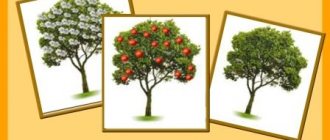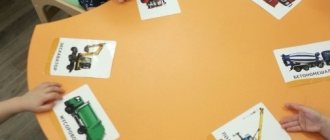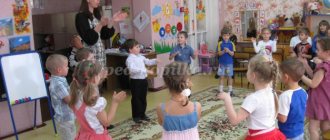GCD in the preparatory speech therapy group Topic: “Transport”
Correctional and educational goals.
- Expanding and consolidating ideas about transport based on generalization of previously formed ideas.
- Clarification, expansion and activation of the dictionary on the topic “Transport”.
- Formation of ideas about types of transport.
- Improving the grammatical structure of speech.
Correctional and developmental goals: development of visual attention and perception, speech hearing, fine and gross motor skills, creative imagination.
Educational goals: developing skills of cooperation, independence, initiative, goodwill.
Equipment: magnetic board, object pictures with images of transport, a container with pencils, a ball, a “noisy picture”, sheets of paper with images of rectangles, a reference table for composing a story.
1. Organizational moment. Game "I have...". (Agreement of nouns with numerals.)
The teacher greets the children, invites them into the office and invites them to stand near the chairs. Each child has an object picture on their chair.
Educator: Look at your pictures, count the vehicles on them. Take turns sitting down and tell them what is shown in your pictures.
1st child: I have two cars.
2nd child: I have five planes.
3rd child: I have five helicopters
4th child: I have two ships.
Educator: Well done! You did an excellent job.
2. Conversation with children about transport while looking at pictures. (Expansion and consolidation of ideas about transport based on the generalization of previously formed ideas. Consolidation of the concepts of “freight” and “passenger” transport. Formation of ideas about types of transport.)
The teacher places pictures on the magnetic board: trolleybus, bus, tram.
Educator: What kind of transport is this?
Children: Passenger transport.
Educator: What is passenger transport needed for?
Children: For transporting passengers.
The teacher places pictures on the magnetic board: truck, dump truck, van.
Educator: What kind of transport do you see?
Children: This is a freight transport.
Educator: Correct. Where does all this transport move?
Children: On the way.
Educator: And that’s why it’s called road transport.
Work is carried out similarly with air, water, rail, and underground transport.
3. Outdoor game “Motor ship” (coordination of speech with movement)
| From the green pier | Step forward, hands down |
| The ship pushed off. | |
| One, two - | Two steps back |
| He took a step back first. | |
| And then he stepped forward - | Two steps forward |
| One, two - | |
| And he swam, swam along the river, | Arms extended forward and closed - |
| Getting into full swing. | This is the bow of the ship. Movement in a circle in small steps. |
4. “Compiling stories based on individual pictures using a reference table” (Development of coherent speech.)
Educator: We named all types of transport. And now, each of you will take one picture and make up your own story and transport according to the table.
The teacher places a reference table on the board, with the help of which each child composes a story based on his individual picture.
Educator: Well done! And now I offer you a new game.
5. Game “Recognize objects” (Development of imagination, visual attention.)
Children are offered a picture depicting “noisy” objects (transport).
Children must recognize and name objects.
6. Game “Draw the rectangles to make a vehicle.” (Development of manual motor skills, visual perception, attention, imagination.)
The teacher gives the children sheets of paper on which rectangles of various sizes and simple pencils are depicted.
Educator: Look, there are drawn rectangles in front of you. Make these rectangles turn into vehicles.
Children complete tasks and then say what they did.
7. Game “What’s extra?” with a ball. (Development of speech hearing.)
The teacher invites the children to go to the carpet and play a game.
Educator: And the last task today. I list the names of the vehicles and throw the ball, and each of you, having caught the ball, determines what is unnecessary and why.
Educator: bus, car, bulldozer.
Child: An extra bulldozer, because... it refers to construction equipment, and a car and a bus are passenger transport.
A similar task is given to each child.
8. End of the lesson: (Assessment of children’s work.)
Children list the tasks they have completed and evaluate each other's work.
Notes on the lexical topic “Transport” for children 4-5 years old with severe speech impairments
A series of notes on the lexical topic "Transport" for children 4-5 years old with severe speech impairments
Description of work: this work contains 3 notes on direct educational activities on the lexical topic "Transport" for children 4-5 years old with severe speech impairments . The material is built on the principle of “from simple to complex” and corresponds to the objectives of “Speech therapy work to overcome ODD in children.” Didactic games and exercises offered in the notes contribute to the development of:
- phonemic awareness; — mental processes; - vocabulary and grammatical structure of speech; - connected speech.
Summary of lesson No. 1 on the topic “Transport”
Goal: to expand children’s understanding of transport. Objectives: 1. Continue teaching children to form nouns with diminutive suffixes. 2. Develop children’s ability to name a group of homogeneous objects with a generalizing word. 3. Strengthen children’s ability to answer questions in complete sentences. 4. Develop attention, memory, thinking, fine motor skills. Equipment: demonstration material: plot picture “Transport”; subject pictures depicting a car, truck, bus, plane, ship, train; pictures for the game “Big-Small”. handout: handout for the game “Trace the Truck and Color It.” Progress of the lesson I.Org.moment. 1.D/i “Choose an action.” II.Work on the topic of the lesson. 1. Conversation on the topic. The speech therapist shows the children the plot picture “Transport”. -Guys, look carefully at the picture and tell me what kind of transport you see in it? 2.D/i “Name the transport.” The speech therapist puts object pictures depicting transport on a typesetting canvas, and the children name them. 3.D/i “Name it in one word.” — Tell me, guys, what is transport needed for? (To transport people, goods.) - What can you call people who travel in transport? (Passengers.) 4.D/i “Parts of the machine.” The teacher shows the children a picture of a car and asks the children what parts it has. (The car has a cabin, body, wheels.) III. Physical education minute. “Truck” The truck is carrying sand. They walk in a circle, pretending to turn the steering wheel. The people are surprised: They stop, turn their faces in a circle, spread their arms, and make surprised faces. “This is such a miracle, miracles, There is sand in it under the sky.” Tilt your head right and left twice. They stretch on their toes, raising their arms up. IV.Continuation of work on the topic of the lesson. 1.D/i “Big-small”. 2.Work with the handout “Trace the truck by dots and color it.” V. Result.
Summary of lesson No. 2 on the topic “Transport”
Goal: to continue to expand children’s understanding of transport. Objectives: 1. Continue teaching children to write a short descriptive story using support cards. 2. Exercise children in understanding and using the prepositions “To”, “PO”, “FROM”, “ABOUT”, “ON”, “B”. 3. Strengthen children’s ability to guess an object based on essential features. 4.Develop attention, memory, thinking, fine motor skills. Equipment: demonstration material: subject pictures depicting transport; picture with the image of Dunno; pictures for the game “Where? Where? Where?"; support cards; pictures for the game "4 extra". Progress of the lesson I.Org.moment. D/i “Flies or doesn’t fly”: ship, bee, plane, sofa, rocket, truck, helicopter, car, bus, bullfinch. II.Work on the topic of the lesson. 1. D/i “Guess by the description.” The teacher tells the children that Dunno has come to visit and wants to play with them. — It's a big blue car. It has two wings and a tail. He's flying across the sky. (Airplane.) - This machine is needed to transport cargo. It has a cab, a body and wheels. (Truck.) - This vehicle is large and it has sails. It floats on water and transports people and cargo. (Ship.) - This transport travels on rails. He has a lot of carriages. He puffs: “Chuh-chukh-chukh.” (Train.) - We always use this transport to go to kindergarten and to work. (Bus, car.) 2. D/i “Name the transport.” 3. D/i “Name it in one word.” 4. Understanding and use of the prepositions “K”, “PO”, “FROM”, “ABOUT”, “ON”, “B”. D/i “Where? Where? Where?" The teacher shows the children pictures and asks questions: - Where does the bus (truck, train) go? (The bus is traveling on the road. The train is traveling on the rails. Etc.) - Where did the bus (truck, train) arrive? (The bus pulled up to the stop. The truck pulled up to the garage. The train pulled up to the station. Etc.) - Where did the bus stop? — Where did the bus (truck, train) leave from? (The bus pulled away from the stop. The truck pulled away from the garage. The train pulled out of the station.) - Where is the ship sailing? (The ship is sailing on the sea.) - Where did the ship sail to? (The ship sailed to the shore.) - Where did the ship sail from? (The ship sailed from the shore.) - Where is the plane flying? (The plane flies in the sky.) - Where did the plane take off from? (The plane took off from the ground.) - Where did the plane land? (The plane landed on the ground.) III. Physical education minute. IV.Continuation of work on the topic of the lesson. 1. Compilation of a short descriptive story on the topic. The teacher shows the children support cards and gives a sample story: - This is a truck.
A truck is a transport. Its body is red and its cabin is green. He is big. He transports goods. Then 2-3 children make up a story about their favorite transport using an analogy.
2.D/i “4 extra”. V. Result.
Summary of lesson No. 3 on the topic “Transport”
Goal: to consolidate children’s knowledge about transport. Objectives: 1. Continue to teach children to understand the content of the story and answer questions about the text. 2.Develop children’s ability to solve riddles. 3. Clarify, activate and develop vocabulary on the topic. 4.Develop attention, memory, thinking, fine motor skills. Equipment: demonstration material: picture of Dunno; subject pictures depicting transport; pictures from the story “Special machines”. handout: copybook. Progress of the lesson I.Org.moment. D/i “The one who tells me the transport will sit.” II.Work on the topic of the lesson. 1. Riddles of Dunno. The brothers got ready for a visit, clung to each other and rushed off on a long journey, only leaving a smoke behind. (Train.) It doesn’t flap its wings, but flies, Not a bird, but overtakes everyone. (Airplane.) A steam locomotive without wheels, That's a miracle locomotive. Has he gone crazy - walked straight across the sea? (Ship.) It doesn’t fly, it doesn’t buzz, the beetle is running down the street. And they burn in the beetle’s eyes - Two brilliant lights. (Car.) 2.D/i “Name the transport.” 3.D/i “Name it in one word.” 4. A speech therapist’s story about special-purpose machines. The speech therapist tells children about special-purpose machines, showing corresponding pictures. -One day, dad and Masha were walking down the street. Suddenly they heard the sound of a siren, and soon a car with a red cross appeared. All the cars immediately gave way to the loud car. “Dad, why is everyone letting this car through?” asked Masha. - Because it is a special machine. Such machines help a person in his work. There are snowplows, sprinklers, police cars. Sometimes, saving someone's life may require immediate help. Then a special ambulance is called. It has modern medical equipment. Doctors provide first aid to a person and, if necessary, can quickly take a seriously ill patient to the hospital. There are also fire trucks. They rush to respond to fire calls. A brigade of firefighters rescues people and, using special equipment, extinguishes the fire with foam and water. Special machines are always in a hurry to help someone. That's why everyone lets them through, Masha! III. Physical education minute. IV.Continuation of work on the topic of the lesson. 1. Conversation on the story “Special Purpose Vehicles.” — What cars did Papa tell Masha about? Tell me guys, what is an ambulance/fire truck for? What other special machines do you know? Why do people need special cars? 2. Working with copybooks. V. Result.
We recommend watching:
Summary of a lesson on speech development in the middle group on the topic: “Ukraine is my native land” Experience of a speech therapist teacher in a preschool educational institution Automation of whistling and hissing sounds in children in pictures The work of a speech therapist with parents in a preschool educational institution in accordance with the Federal State Educational Standard. Correction of speech disorders
Similar articles:
Summary of a lesson on speech development in the middle group on the topic “Our Street”



